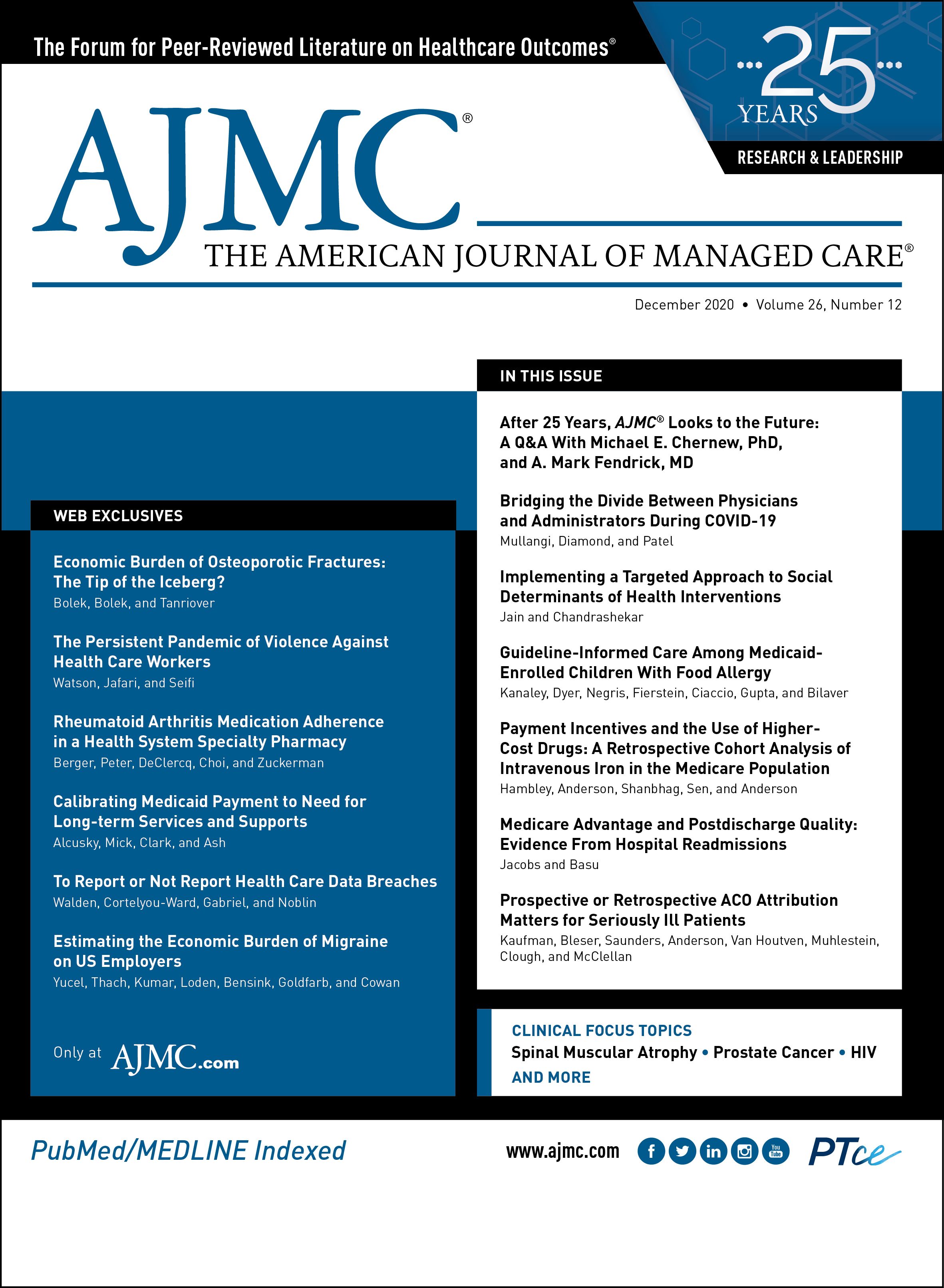- Center on Health Equity & Access
- Clinical
- Health Care Cost
- Health Care Delivery
- Insurance
- Policy
- Technology
- Value-Based Care
Economic Burden of Osteoporotic Fractures: The Tip of the Iceberg?
The economic burden of osteoporotic fractures may be much higher than estimated: just the tip of the iceberg. In this letter, we suggest that the cost of these fractures might be underestimated by considering only direct medical cost.
Am J Manag Care. 2020;26(12):e376. https://doi.org/10.37765/ajmc.2020.88542
We recently read with great interest the article written by Williams et al titled “Economic Burden of Osteoporotic Fractures in US Managed Care Enrollees,” published in the May 2020 issue of The American Journal of Managed Care®.1 Osteoporosis is a major public health problem, and fractures constitute the most important clinical complication of osteoporosis. Williams et al demonstrated the direct medical cost of osteoporotic fractures, which is extremely valuable for drawing attention to aspects of the disease other than medical consequences. As the cited study pointed out a significant economic burden associated with osteoporotic fractures, we would like to augment this conclusion with a comment on other costs of osteoporotic fractures.
Cost-of-illness (COI) studies are important to demonstrate the real burden of diseases and establish health policies. Costs can be classified into 3 categories: direct, indirect, and intangible. Direct cost includes direct medical cost (related to disease treatment) and direct nonmedical cost (such as for transportation, accommodation, and meals).2 Indirect cost refers to the expenses incurred due to loss of productivity, which can be measured and defined as absenteeism and presenteeism. Intangible cost, which cannot be measured quantitatively, includes pain, suffering, and psychiatric problems. Although most of the COI studies so far have mainly focused on direct medical cost, direct nonmedical and indirect costs should not be ignored.2 Although data on the direct nonmedical cost of osteoporotic fractures are scarce, they can be extrapolated from the work of Qu et al, who reported that the direct nonmedical cost was equal to 8% of the direct medical cost of osteoporotic fractures.3 As for the calculation of the indirect cost of osteoporotic fractures, although absenteeism rates may vary depending on the location of the fracture, usually 16% of patients and 8% of family members take time off from work.4 Patients with fractures have 2 more weeks per year of absenteeism than those without fractures. The 1-year cumulative mortality rate after osteoporotic hip fracture varies between 20% and 40%.5 In addition to time off from work, premature deaths are another cause of productivity loss. The indirect cost of fractures due to absenteeism is almost one-third of the total cost of fractures for employed patients in the United States.6 Premature deaths and patients’ and caregivers’ absenteeism result in significant loss of productivity, which leads to a considerable amount of indirect cost.
To sum up, when direct nonmedical and indirect costs are taken into account in addition to direct medical cost, it is evident that the economic burden of osteoporotic fractures on the involved individuals, on the health care system, and on national economies is more significant than previously calculated. The most effective approach to prevent this burden is to change the modifiable risk factors of the patients, develop public programs to prevent osteoporosis, and make interventions to prevent falls.
Author Affiliations: Department of Internal Medicine (HB, MDT) and Division of Rheumatology (ECB), Hacettepe University Faculty of Medicine, Ankara, Turkey.
Source of Funding: None.
Author Disclosures: The authors report no relationship or financial interest with any entity that would pose a conflict of interest with the subject matter of this article.
Authorship Information: Concept and design (HB, ECB, MDT); drafting of the manuscript (HB, ECB); critical revision of the manuscript for important intellectual content (ECB, MDT); and supervision (HB, MDT).
Address Correspondence to: Hatice Bolek, MD, Department of Internal Medicine, Hacettepe University Faculty of Medicine, Gevher Nesibe St, 06100 Sıhhiye, Ankara, Turkey. Email: hati.kocc@gmail.com.
REFERENCES
1. Williams SA, Chastek B, Sundquist K, et al. Economic burden of osteoporotic fractures in US managed care enrollees. Am J Manag Care. 2020;26(5):e142-e149. doi:10.37765/ajmc.2020.43156
2. Drummond MF, Sculpher MJ, Claxton K, Stoddart GL, Torrance GW. Methods for the Economic Evaluation of Health Care Programmes. 4th ed. Oxford University Press; 2015.
3. Qu B, Ma Y, Yan M, et al. The economic burden of fracture patients with osteoporosis in western China. Osteoporosis Int. 2014;25(7):1853-1860. doi:10.1007/s00198-014-2699-0
4. Pasco JA, Sanders KM, Hoekstra FM, Henry MJ, Nicholson GC, Kotowicz MA. The human cost of fracture. Osteoporosis Int. 2005;16(12):2046-2052. doi:10.1007/s00198-005-1997-y
5. Guzon-Illescas O, Fernandez EP, Villarias NC, et al. Mortality after osteoporotic hip fracture: incidence, trends, and associated factors. J Orthop Surg Res. 2019;14(1):203. doi:10.1186/s13018-019-1226-6
6. Pike C, Birnbaum HG, Schiller M, Sharma H, Burge R, Edgell ET. Direct and indirect costs of non-vertebral fracture patients with osteoporosis in the US. Pharmacoeconomics. 2010;28(5):395-409. doi:10.2165/11531040-000000000-00000

Trends in Hospital Pricing for Vulnerable Emergency Department Users, 2021-2023
December 4th 2025Self-pay emergency department prices rose significantly from 2021 to 2023, especially at for-profit and system-affiliated hospitals, highlighting growing affordability challenges for uninsured and underinsured patients.
Read More
Integrated Care for Chronic Conditions: A Randomized Care Management Trial
December 3rd 2025The authors sought to understand the differential impact of payer-led community-based care management approaches on stakeholder-oriented outcomes for publicly insured adults with multiple chronic conditions.
Read More

